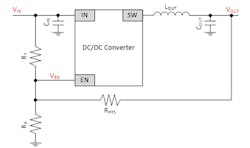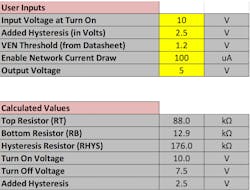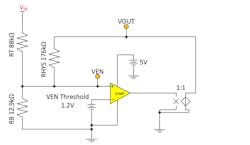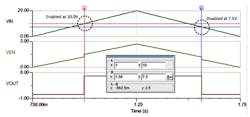Download this article in PDF format.
Today’s dc-dc converters use an enable pin to control the design conditions at which the power supply turns on and off. However, your dc-dc converter may not have this “enable hysteresis” control, or the internal hysteresis value may be too small. It is possible to add an adjustable hysteresis to your dc-dc converter’s enable signal, though. You can replicate this technique by using Excel spreadsheet calculations, Texas Instruments (TI) TINA-TI software simulations, and evaluation-module (EVM) testing.
It’s standard electrical engineering practice to add feedback around a comparator using a hysteresis resistor (adding feedback). You can apply this same idea to a dc-dc converter by adding a resistor connecting the enable signal to the output voltage. By adding the output voltage to the enable signal, the enable signal will be pulled even higher once the converter produces an output (Fig. 1).
1. Hysteresis can be added to a dc-dc converter by adding a resistor connecting the enable signal to the output voltage.
Equations 1 through 4 are used calculate the correct resistor values based on the design parameters:
where RT is the top feedback resistor in the enable-resistor network, RB is the bottom feedback resistor in the enable-resistor network, VON is the desired input voltage for turn-on, VOFF is the desired input voltage for turn-off, RHYS is the hysteresis resistor, IDRAW is the current drawn by the enable-resistor network, and VEN is the enable-threshold voltage (a datasheet specification).
An example shows how the analysis translates into actual values. Here, the converter will be enabled once the input voltage reaches 10 V. Once on, the input voltage will decrease down to 7.5 V before the converter becomes disabled. This means designing a system hysteresis of 2.5 V into the enable signal. The specific design parameters are:
- VIN (typical) = 12 V
- VON = 10 V
- VOFF = 7.5 V
- VOUT = 5 V
- VEN = 1.2 V (no internal hysteresis)
Now let’s look at the calculations, simulations, and test data for this additional hysteresis.
Step 1: Use the design calculator to determine resistor values
The Excel design calculator can calculate the resistor values corresponding to your desired design parameters. In the yellow boxes (see table), enter the preferred turn-on voltage, the amount of added hysteresis, the VEN threshold, the total desired current draw, and the output voltage. Use the enable-resistor network-current draw entry to select how much current, in microamperes, you will budget for the enable network. Selecting a smaller value will increase the resistor magnitudes.
The Excel calculator quickly recommends the appropriate component values for the desired VON and VOFF. The table also shows the calculated RT, RB, and RHYS values to meet the input criteria.
Step 2: Simulate the values using TINA-TI software
You can use the TINA-TI SPICE-Based Analog Simulation Program to simulate turn-on and turn-off performance with the calculated resistor values. Adjust RT, RB, RHYS, VEN, and VOUT amplitude to match your design calculations. Figure 2 shows the TINA-TI Simulation schematic that can be adjusted to test out different values.
2. This circuit model is used for the Spice simulation of the added hysteresis to assess the impact of the resistor values.
The Excel calculator quickly recommends the appropriate component values for the desired VON and VOFF (see bottom of table), where the RT, RB, and RHYS values that have been calculated to meet the input criteria are shown.
Click Analysis and then Transient Analysis to run the simulation. Running from 750 ms to 1.75 s will show a full turn-on and turn-off cycle (Fig. 3).
3. The full turn-on/turn-off cycle is clearly visible in the TINA-TI simulation transient results.
Step 3: Validate on an EVM
Actual wiring of the hysteresis resistor to the available EVM allows for testing in the lab. For this example, the TI LM73605 EVM was used with a small resistive load and a signal generator to provide the input ramp waveform. Figure 4 demonstrates the physical implementation of the hysteresis example with results measured on an oscilloscope.
4. A signal generator is used to provide the input ramp waveform, enabling the evaluation module to show the input, output, and hysteresis signal.
Conclusion
The Excel calculator allows for quick design of a hysteresis network. The simulation files prove the mathematical validity, showing the same turn-on and turn-off threshold values as the calculator. Finally, testing in the lab proves that at the applications level, the turn-on and turn-off thresholds are very close to the ideal, corresponding to the calculator. The Excel calculator, simulation tools, and EVM testing provide a quick and accurate method to add hysteresis to your dc-dc converter.
Reed Kaczmarek is Texas Instruments’ analog field applications engineer for the mid-west U.S. industrial market. He has expertise in a variety of power-supply designs, including point-of-load dc-dc and isolated ac-dc supplies. Reed holds a Bachelor of Science in Electrical Engineering from the University of Maryland.







